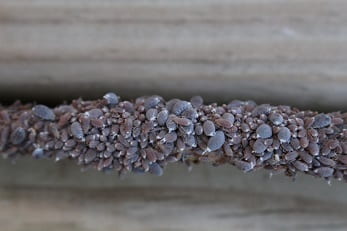–Dr. Raymond Cloyd
We have received numerous inquiries regarding insects feeding on maple trees including sugar (Acer saccharum), Norway (Acer platanoides), and silver (Acer saccharinum). These insects are woolly aphids. Woolly aphids are a group of aphids that feed on different types of trees, such as; maple (Acer spp.), elm (Ulmus spp.), alder (Alnus spp.), and apple (Malus spp.). Woolly aphids cover themselves with white waxy threads or filaments (Figure 1), which provides protection from natural enemies (parasitoids and predators).
Fig 1. Woolly aphids feeding on maple tree. Note the white waxy threads or filaments (Auth–Jesse Gilmore, Wildcat District)
Woolly aphids are typically found in large numbers feeding on the branches of trees (Figures 2 and 3). In addition, some species of woolly aphids develop initially on roots (e.g. woolly apple aphid, Eriosoma lanigerum) and then later on migrate upward from the soil to feed on plant stems and branches. Woolly aphids feed on plant fluids within the phloem sieve tubes. They withdraw large quantities of plant fluids resulting in the production of honeydew, a clear sticky liquid that serves as a substrate for black sooty mold.
Fig 2. Woolly aphids feeding on maple tree (Auth–Jesse Gilmore, Wildcat District)
Fig 3. Woolly aphids feeding on maple tree branch (Auth–Raymond Cloyd, KSU)
Young woolly aphids are all females (stem mothers) and can reproduce asexually (without mating). Winged and non-winged forms may be present simultaneously. The cornicles or tubes that protrude from the end of the abdomen may be substantially reduced compared to other aphid species (Figure 4).
Woolly aphids feed on mature maple trees and are not likely to cause significant plant damage. However, one of the easiest and quickest ways to remove woolly aphids from maple trees is to dislodge them using a forceful water spray. If done whenever woolly aphids are present, a forceful water spray will prevent populations from building-up. Although there are predators that will feed on woolly aphids including green lacewings, ladybird beetles, and syrphid fly larvae, in most cases, the predators do not provide sufficient regulation of woolly aphid populations.
Fig 4. Close up of woolly aphids feeding on maple branch. Note the reduced cornicles on the end of the abdomen (Auth–Raymond Cloyd, KSU)



